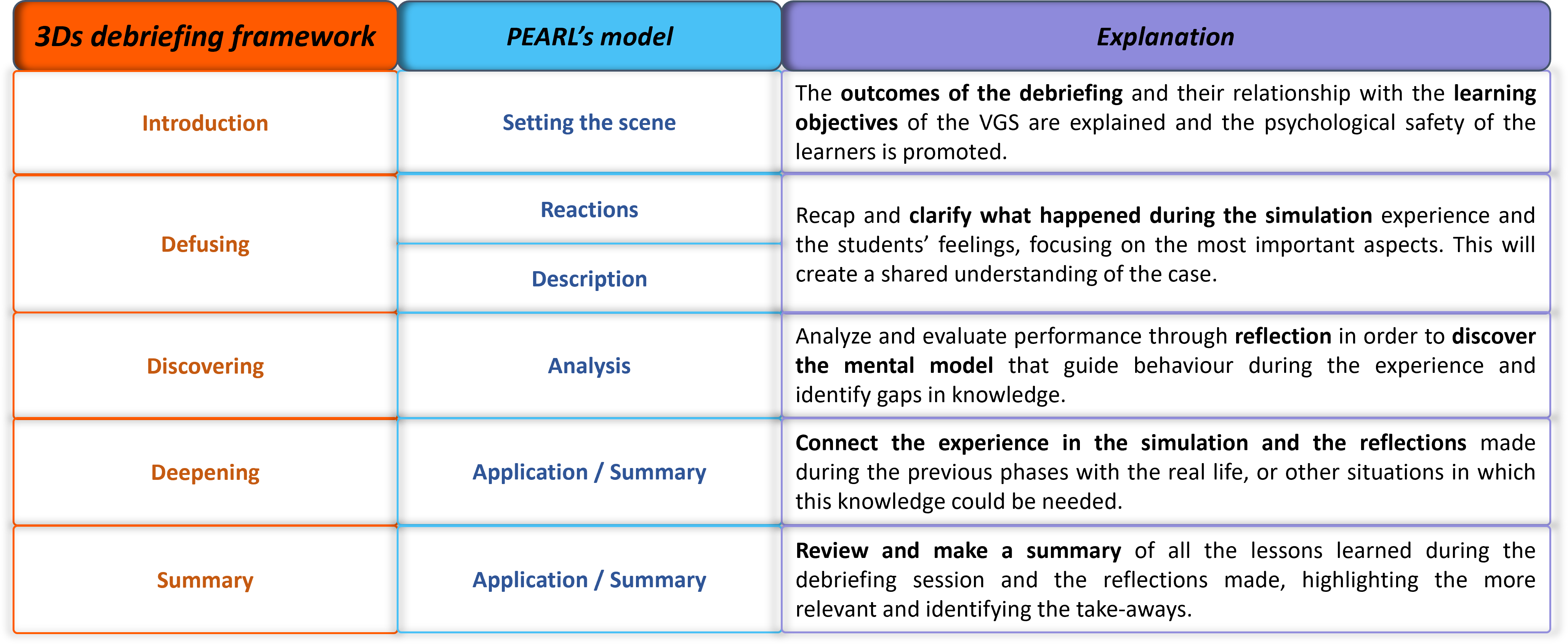26 The debriefing
What to do
Define the debriefing of the virtual gaming simulation (VGS).
How to do it
Debriefing is an essential part of the VGS process. Although experience and practice are the basis of adults learning, Kolb’s experiential learning theory emphasizes the importance of reflection on the experience to identify knowledge gaps and develop new understanding. Analysing values and assumptions and finally create new ideas and knowledge that can be transfer into other situations (Maestre & Rudolph, 2015). Therefore, debriefing plays a key role in VGS by promoting reflection in learners about the simulated experience (Aebersold, 2018; Hall & Tori, 2017; Verkuyl et al., 2020; Zigmont et al., 2011b). Some authors go as far as to say that “the actual learning does not occur during the experience itself, but rather during the debriefing that follows” (Zigmont et al., 2011b, p. 49).
For this reason, designers should devote significant attention to planning the debriefing content for their VGS. The primary objective of debriefing should be to help students understand, evaluate, refine, and enhance the mental models that guide their behaviour in a professional environment, and which influenced their decisions during the simulation (Zigmont et al., 2011b).
To ensure that students properly analyse and reflect on their simulation experience, we highly recommend following a structured debriefing model. These models typically contain several stages that guide students through a step-by-step reflection process, helping them to deepen their understanding of their practice and discover their mental structures. Two recommended models include:
- Zigmont, et al (2011a) The 3D’s model of debriefing framework
- Bajaj et al. (2018) The PEARL’s model
Next figure contains a description of the phases of both models combined:

Advice
We strongly recommend structuring the debriefing process according to one of these established models and ensuring that all aspects of the model are covered in order to design an effective debriefing session. By doing so, students will be able to fully engage in the reflection process, and gain a deeper understanding of their performance during the simulation
For the design of a VGS, it is important that an online self-debriefing is planned and included into the platform by the designers, so that the students have access to it at the end of the enactment phase.
During the online debriefing, it is important to include several explanations and questions about the learning experience, including:
- A general explanation of the debriefing phase, its goals, and the importance of maintaining confidentiality to ensure that learners can freely express their thoughts.
- An invitation for learners to describe their experience in the simulation, incorporating both objective data and their feelings.
- An invitation for learners to evaluate their performance based on their reflection of their performance, the feedback they received or the consequences they experienced during the simulation and the feelings experienced. The debriefing questions can be focused on each of these elements in order to facilitate a deeper analysis of the experience.
- An invitation for learners to relate the experience to situations in their lives where the acquired knowledge could be applied. This will strengthen learning and promote its transferability to other situations.
- A final review of the experience and an invitation for learners to select the key aspect that they would choose as their take-home message.
A facilitator led virtual or face-to-face group debriefing sessions following a self-debriefing has been reported to be a very effective debriefing technique (Verkuyl et al., 2020). Although, VGS designers can recommend this practice, debriefing methods beyond the self-debriefing are beyond the scope of the VGS design process. Individual educators who embed virtual simulation within their teaching are ultimately responsible for determining the debriefing method that will be used.
Complementary resources
More information about debriefing:
-
-
- Zigmont, J., Kappus, L., & Sudikoff, S. (2011). The 3D model of debriefing: defusing, discovery, and deepening. Seminars in Perinatology, 35(2), 52-58. https://doi.org/10.1053/j.semperi.2011.01.003.
- Bajaj, K., Meguerdichian, M., Thoma, B., Huang, S., Eppich, W., & Cheng, A. (2018). The PEARLS Healthcare Debriefing Tool. Academic Medicine: Journal of the Association of American Medical Colleges, 93(2), 336. https://doi.org/10.1097/ACM.0000000000002035
-
The ENVISION experience:

